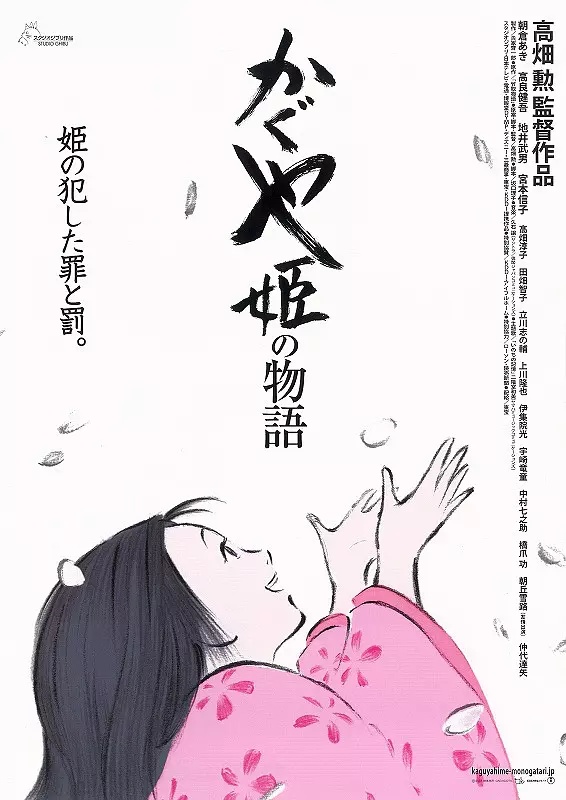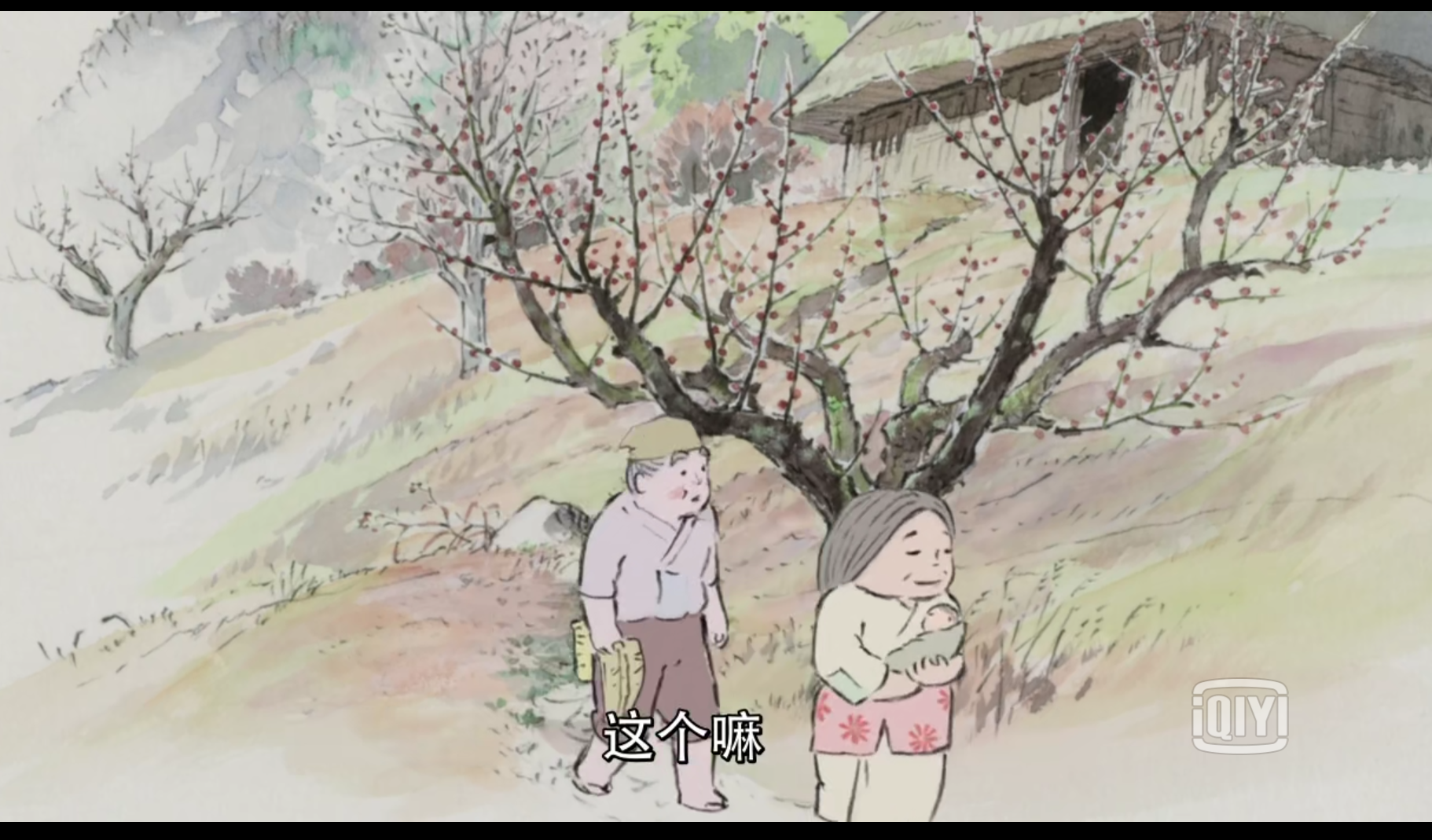
The Tale of Kaguya Hime is a classic old-school Japanese animated film based on the ancient Japanese book of tale tales called “Takeshi Tale”. The most striking thing is that the main style of this work is the watercolor style, which is rare in Ghibli animations. It is worth emphasizing here that the images of “Hime no Hime” look like traditional Chinese ink paintings, but they are actually the traditional culture of Japanese painting – the use of birds and animals.
The Tale of Kaguya Hime, which began as a relatively simple story, is enriched by the skill of director Takahata, one of Ghibli’s master craftsmen.
The old man, Takeshatori, is cutting down bamboo when he picks up a little pink doll from the bamboo shoots. The old, childless man and his wife were delighted, thinking that this miraculous child was a gift from the merciful heavens. The little girl grew up much faster than the other children, just like the bamboo in the forest. This was very strange and interesting to the children who played with her, so they gave her a name – “Bamboo”.
“Bamboo” grew up day by day, she and her friends went over the mountains, catching pheasants, collecting mushrooms and grapes, happy as a free bird. One day, the old man took the bamboo and chopped out a lot of gold and beautiful clothes from the bamboo on the mountain. The old man thought that the mountain environment would make the child a country girl rather than a high and mighty princess. So, he bought a luxurious mansion in the capital, hired a teacher from the palace, and intended to raise Bamboo to be a real lady.

She felt like a canary in a cage, unable to be free. When “Bamboo” had her Bar Mitzvah, the old man asked the lord of the palace to name her. As soon as he saw her, he was instantly amazed by her beauty and thought she could compete with the sun and the moon, so he named her Kaguyahime.
Teruyahime grew up day by day, and her fame gradually spread, and everyone, from ordinary people to princes and aristocrats, gathered around the mansion and asked the old man’s daughter to marry him. The irony was that these men, who kept saying they loved Kaguya Hime, were not sincere in their actions. On the inside, these men never looked down on Kaguya Hime. They only treated her as an object, something that could be traded for glory, wealth and power.
Kaguya Hime yearned for the freedom of the mountains, but was bound to the hopelessness of the capital. Eventually, the desperate princess of the Moon Palace began to ask the moon for help. Finally, one day, someone from the moon came, and although Kaguya-hime could not let go of her parents and the beauty of the human world, she had to put on a coat of feathers to erase her memories and fly to the empty and lonely moon.
The central meaning of the film can be summed up in the classic and literary words: May you still feel worthy in this world, even after going through mountains and rivers.
Kaguya Hime, the princess of the Moon Palace, is a cold and noble immortal who has no feelings or desires. The gods sent her down to earth to experience calamity, so she came down to earth and became the daughter of Takatori and his wife. In heaven, Kaguya Hime was one of the gods and a noble princess. When she was on earth, Takatori and his wife also regarded her as a pearl in the palm of their hands and called her their little princess, treating her as if she were their own.
When Kaguyahime learned to walk, the old man choked with joy. When Kaguyahime was proposed to by many suitors, the old man was so excited that his daughter finally found her “happy home. When Kaguyahime flew to the Moon Palace, Mr. and Mrs. Takatori were in tears and were reluctant to part. From the time she was born until she left, the old man had been extremely devoted to Kaguyahime, and he had been quietly giving from his point of view, hoping that his daughter would find what he considered “happiness. Unfortunately, this was the opposite of what he wanted, and from the beginning to the end, he never asked, and never understood what Kaguyahime really wanted for her happiness.

What Kaguyahime wanted was for her family to live happily in the mountains, in peace and poverty. Every day, she breathed in the mountain breeze, her eyes were filled with the green of the trees, she could drink from the clear stream when she was thirsty, and she could pick berries from the trees when she was hungry. The happiness she wanted was a generation free to run among nature.
The “happiness” and “ultimate destiny” of the princess in the old man’s eyes was to marry a rich and distinguished young man, get married, have children, and become a noble princess envied by all. Obviously, their expectations and values clashed sharply, and this is where the gap between parents and children lies. One wants to go east, the other wants to go west, without understanding each other, and eventually they go against each other and miss each other. This is also the deepest gap and the greatest sorrow between children and parents.
Parents are always looking forward to their children’s success. They are so busy that they can easily ignore their children’s real wishes. When I watched the anime, I was not at all critical of the old man’s actions in arranging Kaguyo-chan’s life for her as a matter of course, regardless of her wishes. As I watched it, I thought of my own parents, and of parents everywhere. As I watched, my eyes turned red.
The old man, Takeshi, should not be criticized. By the worldly standards of the time, a girl’s life was to quickly grow up to be a well-informed and polite lady and marry into a good family. The old man, who had no selfish interest in his work, did everything for his daughter.

When he was finally able to present what he thought was best to his daughter as if it were a treasure, he was painfully surprised to find that it was not what she wanted. The daughter, because of her behavior, was unhappy. Imagine, at this moment, the old man’s heart turning to pieces! It was only then that he realized that everything was just a carnival for him, a meaningless carnival. Alas, he pitied the parents of the world. He saw his building rise, he saw his guests, he saw his building collapse. The moment the princess said she wasn’t happy at all, the old man’s world collapsed. The moment the child told his parents that he was unhappy, the parents’ hearts were broken.
When Kaguya-ji was picked up by the fairy who came up from the moon, I, as an adult, cried so hard that I wanted to grab her by the skirt and ask her, “Little princess, are you leaving just like that? Aren’t you taking mom and dad with you?
From the moment we are born, we say goodbye to our Father in life and in death, they watch us grow up and we watch them grow old. Slowly, we pass them by and miss each other. From infancy to adulthood, we will one day leave our parents. Every goodbye in adulthood is a farewell to life and death, a pain that tears at the heart. To my parents, I have only one thing to say: Walk and cherish.

From the simple and barren mountains to the bustling capital, the little princess saw the beauty of the human world, but also felt the filth and malice of the world. At first, because she could not see what she thought was beautiful, the little princess decided that the earth was not worth living in, and spent her days sulking, lonely to the moon, and asking the gods for help. But when she was about to lose her human qualification, regain her status as a god, and return to the lonely and lonely Moon Palace, she deeply regretted it.
Although the sky was free and clean, it always seemed pale. Before leaving, Kaguyahime truly realized that it was worth the trip to earth. The connection between people, the feelings, the bonds, are the most worthwhile things on earth.
Recent Comments